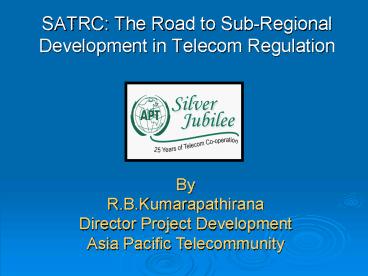SATRC: The Road to SubRegional Development in Telecom Regulation - PowerPoint PPT Presentation
1 / 19
Title:
SATRC: The Road to SubRegional Development in Telecom Regulation
Description:
Fifth SATRC Meeting, Nepal (Sept., 2003) Fourth SATRC Meeting, Bangladesh (Dec., 2002) Third SATRC Meeting, Bhutan (Mar., 2001) Second SATRC Meeting, India (Apr. ... – PowerPoint PPT presentation
Number of Views:32
Avg rating:3.0/5.0
Title: SATRC: The Road to SubRegional Development in Telecom Regulation
1
SATRC The Road to Sub-Regional Development in
Telecom Regulation
ByR.B.KumarapathiranaDirector Project
DevelopmentAsia Pacific Telecommunity
2
SATRC Brief History
To achieve a Harmonized Telecommunications
Regulatory Environment for the South Asian Region
Is a directive of the ITU Regulatory Forum for
South AsiaPrevious SATRC meetings Sri Lanka,
India, Bhutan, Bangladesh, Nepal
3
SATRC Brief History (Contd)
Sixth SATRC Meeting, Pakistan (Sept.,
2004)Fifth SATRC Meeting, Nepal (Sept.,
2003)Fourth SATRC Meeting, Bangladesh (Dec.,
2002)Third SATRC Meeting, Bhutan (Mar.,
2001)Second SATRC Meeting, India (Apr.,
1999)First SATRC Meeting, Sri Lanka (May.,
1998)
4
SATRC Membership
- All Telecom Regulators from SOUTH ASIA
Afghanistan, Bangladesh, Bhutan, India, Iran,
Maldives, Nepal, Pakistan and Sri Lanka
5
SATRC Member Countries
6
Trends in Telecommunications (ECONOMIC)
Economic Recovery Uncertainity
Unpredictability of high-tech sectorDe-centrali
zation, de-regulation and liberalizationMarket
growth for Mobile Telephony and New
ServiceIndustry Transformation Monopoly to
Competition
7
Trends in Telecommunications (TECHNOLOGY)
Need for IP enabled technologies services
Decrease in costs increase in processor
speedIncrease in bandwidth availabilityCircuit
Swithing to Packet SwithcingGrowth in digital
and cellular technologies
8
SATRC Primary Mandates
Discussions Coordination of regulatory issues
in Telecommunications having common interest
among members Discussions on Radio Frequency,
Standardization, Regulation, Policies and
Strategies for Telecommunications
developmentIdentify and promote areas of
potential cooperation and harmonization through
sub-regional seminars, trainings and workshops
9
SATRC Secondary Mandates
Establishing co-operative relationship with
regulators, international, regional or sub
regional organizations.Setting up of Working
Groups when necessary to study and discuss on
specific issues in telecommunications.Revision
of the Terms of Reference (TOR) by consensus.
10
Previous SATRC Activities on Numbering
- Major modifications were ruled out
- Agreed codes were proposed for harmonization to
the countries who have not yet implemented such
services - Resolution SATRC 5-1 was adopted wherein
Emergency services were targeted for
harmonization - As per the Resolution 5-1, India submitted the
Working group on E-NUM for SATRC Members
11
Previous SATRC Activities on QoS
- Need to define benchmarks for Cellular and VOIP
based services - Enforcement Mechanism required to guarantee
service standards and quality to the customer - Six QoS parameters decided by Bhutan meeting
should be adopted by SATRC Members
12
Previous SATRC Activities on Licensing
- SATRC Member countries expressed their concerns
about Licensing issues as their telecom scenario
goes from monopoly to liberalization - Need for an appropriate dispute resolution
mechanism - A final report on Licensing could be prepared by
the Working Group after taking inputs from all
SATRC Members
13
Previous SATRC Activities on USO
- Progress have been made in member countries on as
per their USO definitions (inputs needed from
remaining countries) - Flexible definitions for rural and unserved areas
and appropriate monitoring mechanism for USO. - Choice of funding schemes based on market
demands, industrialization and service
competition - Successfully implemented USO programs could be
the right direction to follow for other members
14
Previous SATRC Activities on Tariff Re-Balancing
- Consultation paper is being prepared on further
reduction of the sub-regional tariff - Studies concerning costing, tariff rebalancing
and settlement charges have been agreed to be
dealt separately - New Working Group on Tariff Rebalancing formed by
Bangladesh, Nepal, India, Pakistan and Sri Lanka
15
Previous SATRC Activities on Regulatory Reforms
and inputs from PRF
- Various member countries are in different stages
of transition from monopoly to competition - Several Countries shared their liberalization
process within their respective countries - Regulatory bodies within the member countries and
their responsibilities were highlighted
16
Proposal from members for SATRC Action Plan (SAP)
- 5th SATRC Meeting in Nepal(2003) decided the need
to convert the key regulatory issues of concerns
to a SATRC Action Plan (SAP). - The SAP will be taking account of the Working
Group reports, presentations from APT/ITU and
previous reports of SATRC Meetings - The APT Management Committee would be requested
to provde budgetary support to implement the SAP
17
SATRC Working Methodology
- Working Groups May continue and complete their
respective assignments and reports - Workshop Workshop may be conducted involving APT
Experts from the region - Guidelines Needed to deal with regulatory issues
with case studies of best practises - Training Training of personnel to help build
institutional capacity in Regulation (with
priority to LDCs)
18
Conclusions and Recommendations
- SATRC Members need to cooperate and coordinate
among each other in a more effective way in order
to achieve a harmonized telecom environment
within the region - A universal working methodolgy should be adopted
by the council to enable effective functioning of
the members in their key areas of regulatory
concerns - ICT Meeting of the Industries could be approved
as an yearly event preceding the SATRC Meeting to
get the private sector perspective from the
region
19
APT Welcomes you to the Sixth South Asian
Telecommunications Regulatory Council (SATRC)
Meeting !
Thank You !































